Postcards from the Year Abroad: Great Danes in a Northern German Manor House
Welcome to ‘Postcards from the Year Abroad’, a new series of blogs by students of Languages and Cultures at University at Exeter, giving us a glimpse into their year abroad experiences. First up is Nell Hargrove, who studies German together with Art History and Visual Culture.
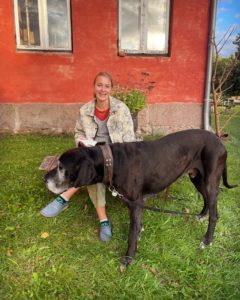 I spent three months in northern Germany for my first placement on my year board in Autumn 2022. I lived in a Gutshaus with my two employers, Knut Splett-Henning and Christina von Ahlefeldt, their three children, two Great Danes, fifteen peacocks and Svamp, a kitten they found in the forest when mushroom picking (‘svamp’ is Danish for mushroom). Svamp the cat and the dogs, Triglaff und Svandevit were not the only Danish connections we had in the house. Christina is a Danish countess and her way of life and design inspirations are very much linked to her Scandinavian roots.
I spent three months in northern Germany for my first placement on my year board in Autumn 2022. I lived in a Gutshaus with my two employers, Knut Splett-Henning and Christina von Ahlefeldt, their three children, two Great Danes, fifteen peacocks and Svamp, a kitten they found in the forest when mushroom picking (‘svamp’ is Danish for mushroom). Svamp the cat and the dogs, Triglaff und Svandevit were not the only Danish connections we had in the house. Christina is a Danish countess and her way of life and design inspirations are very much linked to her Scandinavian roots.
Some say I was in the middle of nowhere (I quickly picked up the term ‘in der Pampe’) but even so, I managed to meet plenty of fascinating people. I keep a diary and in my first two weeks I met a new person each day. Ranging from artists to trendy Berlin weekend-breakers to locals, I treasure the conversations and insights they all offered me.
 It was an extraordinary experience and everyday was different. Guthäuser (plural) are quite unique to the area of Northern Germany and Europe. They were commonly built between the 17th and 19th Centuries for the nobility and families of wealth. This is why they were regarded so negatively in the GDR years in East Germany because they were symbols of social hierarchy. This distaste for the Gutshäuser meant they became neglected and derelict during the 20th century. Knut and Christina are renowned in the region as the ‘Gutshaus-Retter’ because they are constantly taking on huge projects (at the time of my employment, they owned five Guthäuser!) to renovate and bring these falling apart mansions back to life. They even have a successful television show that has documented their work over the last nine years called ‘Mit Mut, Mörtel und ohne Millionen – Die Nordstory’ by NDR and I make an appearance in the most recent episode, knocking down a wall!
It was an extraordinary experience and everyday was different. Guthäuser (plural) are quite unique to the area of Northern Germany and Europe. They were commonly built between the 17th and 19th Centuries for the nobility and families of wealth. This is why they were regarded so negatively in the GDR years in East Germany because they were symbols of social hierarchy. This distaste for the Gutshäuser meant they became neglected and derelict during the 20th century. Knut and Christina are renowned in the region as the ‘Gutshaus-Retter’ because they are constantly taking on huge projects (at the time of my employment, they owned five Guthäuser!) to renovate and bring these falling apart mansions back to life. They even have a successful television show that has documented their work over the last nine years called ‘Mit Mut, Mörtel und ohne Millionen – Die Nordstory’ by NDR and I make an appearance in the most recent episode, knocking down a wall!

I learnt about real estate, ‘Denkmalschutz’ (monument/heritage conservation), hospitality and interior design. Knut had a very good eye for antiques and his wife Christina had formerly been a designer in Copenhagen and London. Gutshaus Rensow, the house we lived in, was built in 1690 and was bought by the couple in 2002. It attracts many guests via their website and Airbnb and has a capacity of 25 people. On three occasions, the whole house was booked for birthday parties and Knut cooked a very delicious roast dinner for everyone. Gutshaus Rensow has also featured in interior design and travel publications. Journalist, Rick Jordan from Condé Nast Traveller stayed for a long weekend and wrote an article about us for the January edition. Another feature of staying at Gutshaus Rensow in the winter was our only source of heating was a wood burner in each room. Guests and I alike would collect our wood in the morning and build a fire every day!

A highlight of mine was during the first week of October when galleries and art institutions across the whole of Mecklenburg-Vorpommern (the Bundesland, like a county) took part in Kunst Heute, a week celebrating contemporary art by showing 133 exhibitions across the Bundesland. Not only did I visit as many as I could and take part in artist workshops, I helped an artist couple, Hubert and Miriam, set up their own art installation at Gutshaus Ramelow, the fifth Gutshaus owned by Knut and Christina.
I am glad I documented my time at Gutshaus Rensow so thoroughly because otherwise, I don’t think I would believe it happened – a truly unique experience and a time I won’t ever forget.
Nobel Prize in Literature awarded to “iconic” French writer Annie Ernaux
On 6th October 2022, Annie Ernaux was announced as the 119th winner of the Nobel Prize in Literature, the 17th woman laureate in the history of the prize. Ernaux is a beloved and iconic writer in France and has been tipped to win the Nobel Prize in Literature for a few years now, yet despite her success in France and elsewhere in Europe she was relatively unknown outside academic contexts in the Anglophone world until the London-based independent press Fitzcarraldo Editions began to publish her work in translations by Alison L. Strayer and Tanya Leslie. By October 2020 Ernaux was Fitzcarraldo’s most published author, and at the time of writing the press has published eight of her works. This is also the third time that a “Fitzcarraldo author” has been awarded the Nobel Prize in Literature (the first two were Svetlana Alexievich and Olga Tokarczuk, and as Anna Cafolla notes in a recent Guardian article, the press also recently published 2004 laureate Elfriede Jelinek). For a young press founded in the spirit of risk, the impact of such a prestigious award cannot be underestimated.
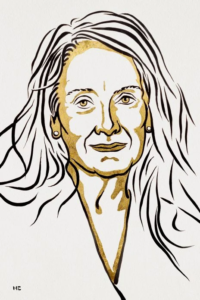
All of the works by Ernaux that Fitzcarraldo have published in English translation are “white covers”, classified as non-fiction (the “blue covers” are Fitzcarraldo’s fictional works), a categorisation that indicates both the autobiographical nature and the historical significance of Ernaux’s work. Ernaux’s award was, the committee notes, for “the courage and clinical acuity with which she uncovers the roots, estrangements and collective restraints of personal memory”, and indeed “collective” is a word frequently associated with Ernaux’s writing. From the “collective autobiography” The Years to the collective memory honoured through her personal experience in texts such as Happening and A Girl’s Story, Ernaux writes about her own life in a way that is inseparable from the time in which she has lived. The committee also mentioned Ernaux’s “clinical acuity”, a description of her writing that highlights her distinctive style: Ernaux writes deep and intense emotions with an observational composure that borders on detachment. In A Girl’s Story (translated by Tanya Leslie), Ernaux describes her own “minute attention to detail” regarding her relationships, and this attention to detail is as true of her writing style as it is of the content.
Almost all of Ernaux’s body of work is written as an attempt to order, make sense of, or immortalise her memories. The first of her books to be published by Fitzcarraldo in English translation was The Years in 2018, translated by Alison L. Strayer and awarded the Warwick Prize for Women in Translation in 2019. Widely regarded as her most important work, Ernaux’s opening line in The Years, “All the images will disappear”, both sets up and sums up her project: every memory of every life – from historical atrocity to TV adverts – will vanish at death, and so we must remember, bear witness, and claim a place in the world. Ernaux herself describes The Years as an “impersonal autobiography,” based on a collection of images and reflections, a narrative framed by photographs of the author at different points throughout her life. The girl and woman in the photographs is never explicitly named as Ernaux, but the series of photos provide the reference points through which her past – and that of her country – is narrated.
Perhaps the most harrowing of Ernaux’s works – and, to return to the Nobel committee’s summary, the most courageous – is Happening (translated by Tanya Leslie), in which Ernaux reconstructs her experience of a clandestine abortion in 1963, supplementing her memory of events with fragments of a journal she kept at the time. Ernaux makes frequent reference to both the act of writing and her sense of responsibility in sharing her story; specifically, she insists on the importance of articulating the reality of clandestine abortions, and the need to resist the complacency of remaining silent about past discriminations simply because they no longer happen. Ernaux demolishes such barriers of silencing and secrecy, putting into words her “extreme human experience” as both a chronicle of a brief period of her life in 1963 and a series of observations in parentheses which represent Ernaux’s reflections on living with the memory of the abortion that almost killed her, the process of writing about it, and how the narrative becomes a force of its own.
Common to both The Years and Happening, as well as to many other of Ernaux’s works, is a sense of responsibility: to record the experiences of her generation, and particularly the experience of women. This, for her, takes precedence over the potential reaction to her work, as she explains in a parenthetical statement in Happening:
“(I realize this account may exasperate or repel some readers; it may also be branded as distasteful. I believe that any experience, whatever its nature, has the inalienable right to be chronicled. There is no such thing as a lesser truth. Moreover, if I failed to go through with this undertaking, I would be guilty of silencing the lives of women and condoning a world governed by the patriarchy.)”
Far from writing a repellent or distasteful text, Ernaux displays immense generosity and compassion in sharing her story. Through the public articulation of her intimate experience, she fulfils a sense of moral responsibility to challenge the patriarchal structures that order her experience of the world.
Throughout her œuvre Ernaux looks back on pivotal moments or relationships with a detached observation that belies deep emotion, and offers a portrait of a particular time, place and milieu that shaped her. In A Girl’s Story (translated by Alison L. Strayer) she exposes what it is to be a woman from a particular background at a particular time in history, in The Years she chronicles the personal impact of major historical events of the twentieth century, in I Remain in Darkness (translated by Tanya Leslie) she explores her mother’s decline from Alzheimer’s, and in A Man’s Place (translated by Tanya Leslie) she offers intimate portraits of her family. These observations – often focusing on women’s subjugation and/or lack of autonomy over their own bodies – are never separate from her personal experience, whether this be the experience of sexual desire in Simple Passion (translated by Tanya Leslie) or of her traumatic illegal abortion in Happening. Indeed, Ernaux is convinced that “of one thing I am certain: these things happened to me so that I might recount them. Maybe the true purpose of my life is for my body, my sensations and my thoughts to become writing” (Happening). By taking personal experience and offering it as literature, Ernaux both inscribes herself into history and uses her role as memoirist to give voice to a generation of anonymous women whose traumas have been systematically silenced.
Though Ernaux may be late to come to the attention of an Anglophone readership, her Nobel recognition was not an entirely unexpected or surprising choice. The prize notoriously favours European authors (indeed, Ernaux is the 16th French laureate) and in recent years has stated an intention to address its lack of women laureates (I might have ranted about this a few times). That Ernaux might be a good “fit” for the Nobel should not, however, detract from the importance of her work: a chronicler of her generation, a perspicacious observer of her own circumstances and the world that shaped her, and a writer with as much compassion as talent, Ernaux is an important author of our times whose work deftly blends the everyday and the momentous, the intimate and the universal.
Helen Vassallo
Associate Professor of French and Translation
Department of Languages, Cultures and Visual Studies
@translatewomen
Translating the Poetry of Birdsong
Poets across time and space have tuned into birdsong. Take the 9th-century Chinese Zen hermit poet, Han Shan (Cold Mountain):
| 寒山棲隱處
絕得雜人過 時逢林內鳥 相共唱山歌 瑞草聯谿谷 老松枕嵯峨 可觀無事客 憩歇在巖阿
|
Where Cold Mountain dwells in peace isn’t on a travelled trail when he meets forest birds each sings their mountain song sacred plants line the streams old pines cling to crags there he is without a care resting on a perilous ledge
Collected Songs of Cold Mountain, trans. by Red Pine (Copper Canyon Press, 2000), pp. 218-19
|
At the 2022 Translation Festival, Sally Flint in tandem with Hugh Roberts, Martin Sorrell and Yue Zhuang ran a session to ‘translate’ a favourite bird into a poem in a short burst of creative writing.
To celebrate National Poetry Day, here are the quick-fire poems produced at that session:
No sound, but a joyous song
A cold January morning in the garden alone.
Dad had died the day before.
A robin perched on a wheelbarrow.
Soundless – one eye watching.
The dark brown eye winked.
Like Dad’s pale blue eye,
It was a joyous song.
Bruce Currey
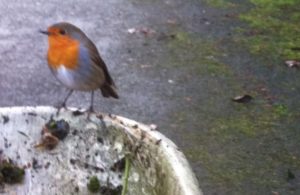
morning coffee
this birdsong is the first sign of spring
it sounds like an “ouh-ouh” to my ear
when I hear it I can feel the sun on my cheek
I can smell my dad’s morning coffee
I can even see the leaves resurfacing
and everything turning into shades of green
I didn’t know where it came from when I was six
but I knew it would be back next spring
Laurine Collardeau
black and white portrait
Fly. Perch. Now!
Down. Up. Check.
Velociraptor walk.
Inspect. Check. Look.
Eat. Pause. Check. Eat.
Eat. Pause. Check. Eat.
Cleverer than clockwork.
Cleverer than you.
Monochrome rainbow.
Hugh Roberts
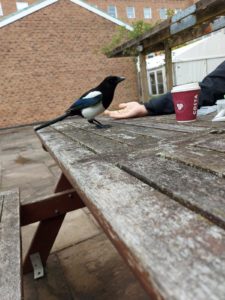
And Martin Sorrell shared his beautiful translation of the ‘Chanson de l’oiseleur’ of the much-loved French poet, Jacques Prévert:
THE BIRD-CATCHER’S SONG
The bird that flies on silent wings
The bird that flies straight into things
The bird as red and warm as blood
The mocking bird the bird of love
The bird that’s eager to take flight
The bird that suddenly takes fright
The bird that has a panic fit
The bird that so much wants to live
The bird that so much wants to cheep
The bird that so much needs to weep
The bird as red and warm as blood
The bird that flies on silent wings
That bird’s your heart you poor wee thing
Your heart that’s fluttering its wings
Inside its cage of firm young ribs.
Translated by Martin Sorrell
MLC Graduations
Where Modern Languages can still take you: Catching up on Graduations in 2022
In June 2022 teaching staff in Modern Languages finally caught up with our graduates from 2020. Alessia, Alice and I spent several joyful hours with those who had studied Italian as part of their degree, most often alongside a range of other languages. It felt like a long time since that dreadful March 2020 when we had last seen them, just before life as we knew it was blasted apart by the COVID-19 pandemic. In some ways, at least as far as education was concerned, that cohort of students were the lucky ones. They had nearly made it through university without anything resembling an online lesson. It was the year after that we were really to descend into the madness of endless hours on Zoom, with cameras off or on, wondering who on earth that student using their Mum’s Zoom account was. Nonetheless, what characterized those early days in March 2020 was total disorientation for students and staff, not the ideal experience just as you are about to embark on final exams. The sudden intimacy of seeing students or staff you have always seen in a neutral classroom sitting in their home environment, family figures and pets often hovering around us, altered the chemistry of how we related as humans. Rather than driving us apart, it brought us closer, strengthening our usual bond with students, and explains in part why we were so moved to see them in person two years later.
In the graduation address, invited speaker, alumnus and sports commentator Rob Walker entertained us with his breathless recreation of the Tokyo mens’ 100 m commentary. But he also reminded us that what is most important about university are the friendships you forge there; friendships that can last you a lifetime and carry you through all life’s major events. How many of us have fallen back on those friendships these last two years? I certainly have, and I hope for our students that they get to keep those bonds too. One of the nicest things about meeting up again is to see how many are still in close contact, or even still living together.
‘So, what are your plans for the… ehm… summer?’. Normally as staff we tend to be quite cautious, in the graduation get-together that follows right after final exams, in enquiring about future plans. No-one wants to add to the high anxiety that often accompanies the big question: What am I going to do with my life? At that age I felt like what I did next would determine everything, and forgot the maxim that life, if we’re lucky, is long and offers us many potential new turns, and even u-turns. This time, however, not only did we meet old friends, but different people. These graduates were forged through two years of experience and experimentation in the ‘real world’ during a moment of global crisis. It had clearly marked them and shaped them dramatically. Sometimes we stood open-mouthed at their maturity and confidence, but it was the diversity of their work choices that reminded us why Modern Languages is such a positive door-opener. The fields of work our 2020 graduates are currently engaged include: recruitment, financial services, communications for Visa, data analysis, interior decorating for an international company, subtitling for ITV, further study in translation, but also in speech and language therapy. It is encouraging to know that at least seven of the eighteen students we met with are going on to teach Modern Languages in schools, often introducing Italian onto the curriculum or via a film club. We can’t wait to meet the 2021 graduates! Watch this space for an update.
Danielle Hipkins (with Alice Farris and Alessia Risi)
Black History along Berlin’s Under- and Overground Network
In the 1920s, Black avant-garde dancer Josephine Baker enchanted not just the likes of Pablo Picasso, Ernest Hemingway and Max Reinhardt but the wider public, including that of Berlin. A few years later, in August 1936, Jesse Owens thrilled the audience attending Berlin’s Olympic Games with his record-breaking performances. These are well-recorded biographical snapshots. Both celebrities paid only fleeting visits to the country: Baker’s home was in France; Jesse Owens returned with the rest of the team to the United States. Meanwhile, some of Germany’s lesser-known Black History can be traced through Berlin’s public transport system – telling stories of daily, no less extraordinary lives over several centuries.

I owe my first example to a Final Year student who referred to it during an oral exam in 2020. He expressed astonishment at his discovery of the quarter around ‘Afrikanische Straße’ while on his way to attend a sports training session. Berlin’s underground line number 6 connects Alt-Tegel in the northwest of the city with Alt-Mariendorf in the south – ‘Alt’ indicates former villages outside the city boundaries. During the Cold War, five out of overall 29 stops along this line were so-called ghost-stations in German Democratic Republic territory. Here, trains would slowly pass through the eerie darkness without stopping. This may be one reason why few of us took much notice of ‘Afrikanische Straße’: you hardly ever travelled this route without a reason. ‘Afrikanische Straße’ reflects that the street-names in the surrounding area are based on Germany’s colonial past: Swakopmund, Ghana, Togo, Windhuk, Kamerun and Sansibar mark the ambitions of the German Empire between 1871 and 1918. Initiatives to replace some of the names have taken a long time to materialize.
These references to Germany’s former colonies are also linked to merchant Carl Hagenbeck (1844-1913). He made his name trading wild animals and promoting zoos with more natural settings. Hagenbeck had ambitious plans for Berlin too. In the late 19th and early 20th centuries, however, large zoos were not simply concerned with exotic animals. Instead, what appealed to visitors, including those of world fairs, were the so-called ‘living villages’ for ‘empirical study and education’. The German term ‘Völkerschau’ translates as ‘observing peoples’ – including their performances of dances and ‘typical’ rituals during opening hours. In Through the Lion Gate Gary Bruce has detailed some of the heart-breaking practices in Berlin where the most popular exhibits included people from
Lapland, Egypt and Cameroon.
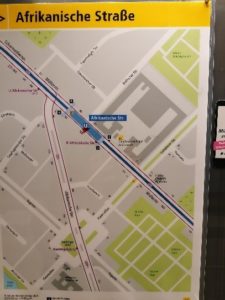
Travel further southeast and, not far from the Brandenburg Gate, one encounters ‘Mohrenstraße’ on line 2. The badly war-damaged station on GDR territory was re-opened in 1950. After several name-changes in praise of German communists (Ernst Thälman, Otto Grotewohl) in 1991, following German Unification, the station’s name became Mohrenstraße. At that point, an urban myth about Mohrenstraße overshadowed everything else: rumour had it, that the spectacular marble inside the station stemmed from Hitler’s Chancellery – sending chills down one’s spine while passing through the station and marking a highlight for visitors touring Berlin. Alas, the marble was prepared after the war.
 There is some speculation how the name of the nearby street Mohrenstraße came about – it may refer to slaves, former black residents or an African delegation, all can be linked to the 17th century. In fact, the archaic reference to ‘Moors’ dates back to the 16th century and was, usually, associated with Black Africans. To this day, one finds – in particular in Austria and Southern Germany – pharmacies and restaurants ‘Zum Mohren’; the practice to associate select chocolates and cakes with the term has stopped. Berlin’s Mohrenstraße caused repeated debates. In 2020, the murder of George Floyd renewed the interest in the name of the station. After the choice of the Russian composer Mikhail Glinka had to be dismissed as a new name, the decision fell on Anton Wilhelm Amo who represents yet another layer of Germany’s Black History.
There is some speculation how the name of the nearby street Mohrenstraße came about – it may refer to slaves, former black residents or an African delegation, all can be linked to the 17th century. In fact, the archaic reference to ‘Moors’ dates back to the 16th century and was, usually, associated with Black Africans. To this day, one finds – in particular in Austria and Southern Germany – pharmacies and restaurants ‘Zum Mohren’; the practice to associate select chocolates and cakes with the term has stopped. Berlin’s Mohrenstraße caused repeated debates. In 2020, the murder of George Floyd renewed the interest in the name of the station. After the choice of the Russian composer Mikhail Glinka had to be dismissed as a new name, the decision fell on Anton Wilhelm Amo who represents yet another layer of Germany’s Black History.
Travelling on (by now over-ground) towards Berlin’s south eastern suburbs, the local museum in Treptow (https://www.museumsportal-berlin.de/en/museums/museum-treptow/) provides an exemplary approach to Germany’s colonial past. Together with other museums and the Initiative Black People in Germany and Berlin Postkolonial, in 2017 Treptow housed a small and powerful exhibition based on the Berlin Trade Exhibition (Gewerbeausstellung) of 1896. In 2021, ‘zurückgeschaut / looking back’ (in cooperation with Dekoloniale Memory Culture in the City) expands the original approach.
 The Trade Exhibition of 1896 attempted to emphasize German commercial and scientific achievements and to affirm the role of the relatively new German capital of Berlin. To visualize the message, Germany’s presumed modernity was set against the exotic ‘natives’ villages’ organized for the occasion. This part of the Gewerbeausstellung ‘aimed to create the greatest possible difference between the population of the “cosmopolitan city” with its alleged “refined customs” and “proud splendour” and the colonised people who would supposedly bring an element of “natural wilderness” and “rawest culture” to the banks of the Spree river.’ One of the exhibition rooms displays the photographs of those who had been lured to Berlin – their work contracts had not clarified that they would be exhibited. While most returned home once the Gewerbeausstellung had closed, twenty stayed, married and had children.
The Trade Exhibition of 1896 attempted to emphasize German commercial and scientific achievements and to affirm the role of the relatively new German capital of Berlin. To visualize the message, Germany’s presumed modernity was set against the exotic ‘natives’ villages’ organized for the occasion. This part of the Gewerbeausstellung ‘aimed to create the greatest possible difference between the population of the “cosmopolitan city” with its alleged “refined customs” and “proud splendour” and the colonised people who would supposedly bring an element of “natural wilderness” and “rawest culture” to the banks of the Spree river.’ One of the exhibition rooms displays the photographs of those who had been lured to Berlin – their work contracts had not clarified that they would be exhibited. While most returned home once the Gewerbeausstellung had closed, twenty stayed, married and had children.
By the 1920s, Berlin had become a cosmopolitan metropolis. In 1927, the German communist Willi Münzenberg took actively part in the ‘First Congress against Colonial Repression and Imperialism’, followed in 1930 by the ‘International Conference of Negro Workers’ in Hamburg. In Berlin, a new underground station in the south west of the city was named Onkel Toms Hütte / Uncle Tom’s Cabin in 1929 in reference to Harriet Beecher Stowe’s novel of 1852. The station provided the modernist housing estate of the same name with access to the city-centre.
However, by the 1930s Germany’s history caught up with some of the children of those who had remained in the country. Martha Ndumbe, daughter of Duala Jacob Njo Ndumbe, died in Ravensbrück concentration camp on 5 February 1944. Josefa van der Want, a Black German dancer and daughter of Josef Bohinge Boholle, died in 1955 ‘from the late effects of the imprisonment in a concentration camp’. Meanwhile, Josephine Baker, the celebrated star of 1920s Berlin, joined the French Resistance against the German occupiers during the Second World War and earned the Croix de guerre and the Rosette de la Résistance.
After the Second World War, with the occupation and division of Germany a new, at times no less challenging chapter for Black History in the country started. Today, about 1 Million Afro-Germans or Black Germans are resident in Germany, predominantly in large cities, including Berlin.
FLANERIE ON CAMPUS – YEAR 12 WORK EXPERIENCE
A Flâneur on campus
The original understanding of a ‘flâneur’ was an upperclass 19th century Parisian man who sought to wander the streets of Haussmann’s new Paris relishing in its rhythms.
Being a 17 year old work experience student I am neither male, upperclass or even Parisian, but that doesn’t mean I can’t still relish. As, to my understanding, to ‘flâneur’ (or should that be flânerie? Or fleurinate?) is to people watch, basically. Earwig. Good old fashioned ‘nosy parkering’.
I’m here visiting Exeter University French Department for the week. I had never been to this university before, didn’t know the history, didn’t know the geography, didn’t know anybody. Or anything. I was clueless. A nosey country girl in the city.
But, boy did I learn! In one lecture I was taught about Francois Mauriac’s novel Thérèse Desqueroux which follows the smothering married life of a woman in the 1920s. A wife trapped by the bars of rain, bars of pine and bars of stubborn traditional etiquette.
In many ways, for this week, I was that wife. Similarly grappling with the bars of stubborn university etiquette. I, the visitor. The newcomer.
The complex language of student etiquette is more foreign to me than the degree level french in which I was to be taught.
For example, I’ve never seen so many gender neutral toilets, and let alone use one! And what is this place Timepiece everyone was talking about…?
My first lecture ‘experience’ was by Fiona Cox. I learnt about the way in which Patrick Modiano is haunted by the spectral atmosphere of Paris in his novel Dora Bruder. This biography is an enigmatic blend of the past and the present, a confrontation of trauma – defined by two isolated concepts; one related to place, the other, observation. Nobel laureate, Modiano suggests that some places, some streets are imbued with the legacy of those who had been there before. In his words, “On se dit qu’au moins les lieux gardent une légère empreinte des personnes qui les ont
habités.”
These words resonate most on analysing the ‘Reflected Vision’ art installation on the Streatham campus. It’s a multidimensional sculpture that reflects the rich multicultural past, and present of Exeter University.
Which got me thinking about its future. It’s a profound notion that no matter how transient a student’s life may be at Exeter, somehow somewhere, someplace, they leave a legacy or even just merely a mark. A shadow of themselves here.
But then what does that mean for me? I am after all just, what Virginia Woolf described as, the ‘street haunter’, a ‘flâneuse’, an outside observer, desperate to know more. Without a shadow of a doubt I can see the enjoyment, the education, and the pleasure that can be gained from within these hallowed Exeter walls. So all I can say is, thank you for letting this 19th century Parisian in. You’ve opened my mind to how learning should be done. Inspired.
Kitty Fisher – Colyton Grammar School
Ladj Ly responding to Victor Hugo
Ladj Ly’s Les Misérables
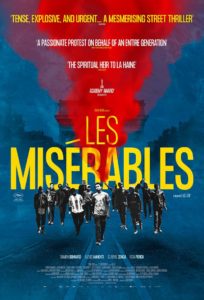 Les Misérables achieved global success and fame as soon as it was published. In exile on Guernsey Hugo would receive fan mail and begging letters from all around the world. The popularity of the work has never dimmed; indeed it has been one of the most filmed and adapted works of all time. The latest film entitled Les Misérables to come out of France is of particular significance, since it was directed by Ladj Ly, the Mali-born French film-maker, who comes from the banlieues in which he set his work. It is by no means an adaptation of Hugo’s book; rather, it is a response to it which, at first sight, has only a few, rather tenuous connections. The strongest of these is that Ly sets the film in Montfermeil, now one of the banlieues in Paris that is inhabited predominantly by those of African heritage, who are, for the most part, poor. We are in the same world as that depicted by Kassovitz in La Haine and, twenty five years after that exploded onto our screens, the tensions are as febrile as they ever were. In literary terms, however, Montfermeil evokes memories of Cosette’s ordeal at the hands of the Thénardiers, whose inn was located in Montfermeil, at that time a village not far from Paris. Then, as now, it was a place inhabited by les misérables; all that has changed is the demographic that represent the outsiders, the wretched within France. Ruiz, a policeman and one of the main characters in Ly’s film, observes laconically that not much has changed, whereupon his colleague observes that Cosette would now be called ‘Causefe’ and Gavroche ‘Gaveroche’.
Les Misérables achieved global success and fame as soon as it was published. In exile on Guernsey Hugo would receive fan mail and begging letters from all around the world. The popularity of the work has never dimmed; indeed it has been one of the most filmed and adapted works of all time. The latest film entitled Les Misérables to come out of France is of particular significance, since it was directed by Ladj Ly, the Mali-born French film-maker, who comes from the banlieues in which he set his work. It is by no means an adaptation of Hugo’s book; rather, it is a response to it which, at first sight, has only a few, rather tenuous connections. The strongest of these is that Ly sets the film in Montfermeil, now one of the banlieues in Paris that is inhabited predominantly by those of African heritage, who are, for the most part, poor. We are in the same world as that depicted by Kassovitz in La Haine and, twenty five years after that exploded onto our screens, the tensions are as febrile as they ever were. In literary terms, however, Montfermeil evokes memories of Cosette’s ordeal at the hands of the Thénardiers, whose inn was located in Montfermeil, at that time a village not far from Paris. Then, as now, it was a place inhabited by les misérables; all that has changed is the demographic that represent the outsiders, the wretched within France. Ruiz, a policeman and one of the main characters in Ly’s film, observes laconically that not much has changed, whereupon his colleague observes that Cosette would now be called ‘Causefe’ and Gavroche ‘Gaveroche’.
The film opens with a vision of the twenty-first century Parisian urchins triumphantly celebrating France’s victory in the 2018 World Cup. A young, black boy strides forth, swathed in a tricolore, and grinning triumphantly. Blink for a moment, and you could almost be looking at the exultant Gavroche standing boldly on the barricades, hailed with encouraging yells and whooping. (It is worth noting that the shooting of Gavroche foreshadows the way in which the twenty-first century police end up accidentally shooting a young black boy, Issa, in Ly’s film.) The opening scene welcomes these black children into the national celebrations – they experience fraternité, as they speak excitedly about the possibility of their heroes such as Mbappé scoring a goal. Football offers an arena where the young people in France’s black community can rejoice in the successes of their own. They happily join in the singing of la Marseillaise, the bloodthirsty brutality of which is highlighted through being sung at an event of national celebration and cheer.
As the black children return from the football match to their homes in the banlieues the happiness and the optimism immediately leaches from the film. They live in a world that is scarred by poverty and in a constant state of alert, poised for visits from and tensions with the police. The film focusses in particular on a trio of policemen who periodically visit the banlieues, both inflaming the tensions longterm, while cracking down hard on them as short-term measures. As a newcomer to the force the policeman Ruiz becomes part of a team that monitors tensions in Montfermeil, and works with Chris, a goading, mean-spirited bully and Gwada who tolerates the way in which Chris targets certain demographics. It is Chris who insists on stopping the car, so that he can go and harass a group of black teenage girls, who are simply waiting for a bus at the bus-stop. When one of them films the harassment as evidence, he smashes her mobile phone. Though he lacks the integrity and self-discipline of Javert, his role of difficult, antagonistic policeman echoes Javert’s capacity to pursue and to hound Jean Valjean. And the targetting of the teenage girls, whose only crime was the colour of their skin, reminds us that nineteenth-century France could be just as gratuitously unjust, as is evidenced at Champmathieu’s trial, when a court official observed that: ‘Je ne sais plus trop son nom. En voilà un qui vous a une mine de bandit. Rien que pour avoir cette figure-là, je l’enverrais aux galères.’ (206). (I can’t quite remember his name any more. But he looks like a brigand, that one. I’d send him to the galleys just for having that face.) Then, as now, the wrong appearance is enough to make individuals vulnerable to arrest. Furthermore, as Gwada and Chris introduce Ruiz to the area, they point out that one of the problems besetting the region is the number of Nigerian prostitutes, reminding us that ‘la déchéance de la femme par la faim’ (the fall of women through hunger) remains one of the evils of the twenty-first century, just as it had been identified by Hugo as one of the core failures of the nineteenth century also.
Les Misérables is a text that is obsessed with falling – there is the moral fall of Jean Valjean from grace, indicated by the title of an early section in the novel ‘La Chute’ (The Fall), which anticipates his literal fall from a ship into the sea; we see Fantine’s fall into prostitution, and Javert’s fall into the Seine, when he commits suicide. Hugo employs the imagery of precipices and vertigo throughout to evoke heart-stopping fear or the annihilating terror of absolute abandonment within the universe or, as in the case of Fantine, the corrosive anxiety of falling so far into poverty that it will prove impossible ever to climb back up and build a life to herself or for her child. ‘Vertige’ ‘escarpements’ ‘chute’ (Vertigo, steep slopes, fall) are words that recur time and time again, highlighting the fragile footing that les misérables have within the world. Ly cleverly mirrors the vertigo within Hugo’s work by situating chunks of the film up on the rooftops, and by following the loops and swoops of a drone, through which we can acquire a bird’s-eye view of the city. Such a vision looks back not only to Les Misérables, but also to Notre Dame de Paris and its famous evocation of Paris in the chapter entitled: ‘Paris à vol d’oiseau’ (A bird’s eye view of Paris). The arrival of the circus in Ly’s film offers an air of carnival that also recalls Notre Dame.
The echoes of Hugo’s works are fleeting yet pervasive. Apart from the fact that the school in Montfermeil is named after Victor Hugo, and Ruiz is thereby prompted to comment on the history of Montfermeil in Les Misérables, we have to wait until the end of the film for a direct reference. The film closes with a close-up of Hugo’s words: ‘Mes amis, retenez bien ceci. Il n’y a ni mauvaises herbes, ni mauvais hommes.Il n’y a que de mauvais cultivateurs.’ (My friends, take heed to what I am going to tell you. There is no such thing as a bad weed, or a bad man. There are simply bad cultivators.) But the overlaying with Hugolian imagery of a story set in the Parisian suburbs inhabited primarily by black people serves as a useful reminder of the fact that Hugo explicitly identifies within Les Misérables with a black man, when he names one of Enjolras’s allies ‘Homère: Hogu nègre.’ The sobriquet is important because it indicates Hugo’s epic ambitions – his epic is the culmination of a tradition extending from Homer to Hugo himself, but also because it enables Hugo to identify with a particular demographic, already vulnerable to exclusion and brutal treatment. Later in the book he indicates that the anguish of les misérables would be experienced amongst peoples and in lands far distant from the France that he evokes, when Thénardier announces that he is going to seek his fortune in America as a slave trader. By opening doors within his novel for such communities Hugo facilitated Ladj Ly’s response, a work depicting communities, technology and weapons that would have been utterly alien to him, even as the conflicts and tensions would have been all too chillingly familiar.
‘Darkness that might be felt’: A Black Woman in Imperial Russia
Black History is widely disputed; sometimes, even the most canonical narratives of Black lives are challenged and critiqued. The autobiographical Narrative of the great abolitionist campaigner Frederick Douglass has been contested by some historians for not going far enough in its condemnation of the American state for tolerating slavery; the life story of the poet (and freed slave) Phyllis Wheatley was appropriated and re-told by a white woman fifty years after Phyllis’ death. Yet other historically important Black life stories are not even read today, let alone critiqued. Nancy Prince, although less well-known today than Douglass or Wheatley, told her astonishing life story in her own words while opening a window onto St Petersburg, the capital of the Russian Empire in the nineteenth century. Her Narrative of the Life and Travels of Mrs Nancy Prince (1850) is still fresh and relevant today, as a page from Black history and as an unexpected view upon Russian history and culture. Extraordinarily, this uneducated Black woman from Massachusetts lived in Russia for nine years (and six months) between 1824 and 1833. She knew two Russian Tsars, or Emperors, and their wives personally. Later in life, after her husband’s death, Nancy travelled in Jamaica, then became a teacher in her native New England, finally writing her memoirs in order to share her inspiring experience and keep food on her table.
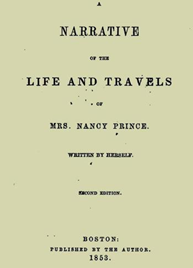 Almost two hundred years ago, Nancy Gardner Prince arrived in St Petersburg with her husband, Nero Prince. Nancy was born free in Newburyport, Massachusetts, in 1799, making her the same age as the poet Aleksandr Pushkin. Since her family was poor, she spent her young adulthood – after her stepfather’s death – doing menial work to support her mother and six younger siblings. Nero had been born in Marlborough, in England; he signed on with a merchant seaman and visited America and Russia several times. A Russian noblewoman hired him as a servant; later, he was given a role on the staff of the Tsar in St Petersburg. This was why Nero returned to the city in 1824, bringing Nancy. His new wife reported her first meeting with his employers at one of the Imperial palaces:
Almost two hundred years ago, Nancy Gardner Prince arrived in St Petersburg with her husband, Nero Prince. Nancy was born free in Newburyport, Massachusetts, in 1799, making her the same age as the poet Aleksandr Pushkin. Since her family was poor, she spent her young adulthood – after her stepfather’s death – doing menial work to support her mother and six younger siblings. Nero had been born in Marlborough, in England; he signed on with a merchant seaman and visited America and Russia several times. A Russian noblewoman hired him as a servant; later, he was given a role on the staff of the Tsar in St Petersburg. This was why Nero returned to the city in 1824, bringing Nancy. His new wife reported her first meeting with his employers at one of the Imperial palaces:
As we passed through the beautiful hall, a door was opened by two colored men in official dress. The Emperor Alexander stood on his throne, in his royal apparel. The throne is circular, elevated two steps from the floor, and covered with scarlet velvet, tasseled with gold; as I entered, the Emperor stepped forward with great politeness and condescension, and welcomed me, and asked several questions; he then accompanied us to the Empress Elizabeth; she stood in her dignity, and received me in the same manner the Emperor had. They presented me with a watch, &c.
Nancy notes: ‘there was no prejudice against color’. Later she describes Russian social conditions in the countryside: ‘The village houses are built of logs corked with oakum, where the peasants reside. This class of people till the land, most of them are slaves and are very degraded. The rich own the poor, but they are not suffered to separate families or sell them off the soil. All are subject to the Emperor, and no nobleman can leave without his permission’. It’s hard not to read comments such as these as implicit critiques of slavery back home in America, where families were routinely separated (like the infant Frederick Douglass from his mother) or sold on to distant farms.
Nancy’s stay in Russia was not all about critical race theory, however. She also gives us enthralling spectator portraits of two major historical events: the Decembrist rebellion of 1825, when a group of liberal Russian officers refused to accept the inauguration of the new Tsar, Nikolai I. In December 1825, they protested in Senate Square, St Petersburg, in favour of the Tsar’s brother, Konstantin; they also demanded a constitutional monarchy and an end to the practice of owning workers and peasants as ‘serfs’ (more soon on the difference between serfs and slaves). Their rebellion was firmly put down within a day, and the ringleaders and their families were executed or sent into Siberian exile. Nancy describes the excitement of that long December afternoon of insurrection, although she gets some details wrong (the Decembrists’ wives were not flogged, and no-one was burned on the scaffold). Even more vivid is her account of surviving the great St Petersburg flood of 1824, when the River Neva burst its banks, drowning an estimated 700 people, mostly in the poorer parts of the city where houses were flimsier (although the whole city was submerged as the waters rose by almost four metres). Most students of Russian learn about this flood when they read (in Russian or English) Aleksandr Pushkin’s famous 1833 poem The Bronze Horseman, in which his hero Evgenii survives by clinging to a stone lion (Evgenii’s fiancée is not so fortunate). Pushkin was not an eyewitness to the catastrophe, but Nancy was. Here is her story:
The morning of this day was fair; there was a high wind. Mr Prince went early to the palace, as it was his turn to serve; our children boarders were gone to school; our servant had gone of an errand. I heard a cry, and to my astonishment, when I looked out to see what was the matter, the waters covered the earth. I had not then learned the language, but I beckoned to the people to come in. The waters continued to rise until 10 o’clock, A.M. The waters were then within two inches of my window, when they ebbed and went out as fast as they had come in, leaving to our view a dreadful sight. The people who came into my house for their safety retired, and I was left alone. At four o’clock in the afternoon, there was darkness that might be felt, such as I had never experienced before. [At 10pm that day…] I then took a lantern, and started to go to a neighbor’s […]. I made my way through a long yard, over the bodies of men and beasts, and when opposite their gate I sunk; I made one grasp, and the earth gave away; I grasped again, and fortunately got hold of the leg of a horse, that had been drowned. I drew myself up, covered with mire, and made my way a little further, when I was knocked down by striking against a boat, that had been washed up and left by the retiring waters; and as I had lost my lantern, I was obliged to grope my way as I could, and feeling along the wall, I at last found the door that I aimed at. […The next day] I went to view the pit into which I had sunk. It was large enough to hold a dozen like myself, where the earth had caved in. Had not the horse been there, I should never again have seen the light of day, and no one would have known my fate. Thus through the providence of God, I escaped from the flood and the pit.
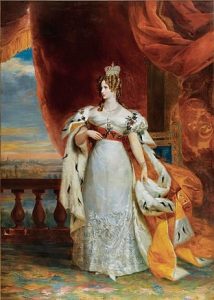 (The poet Pushkin was also Black; you can read more about his heritage here.) Although Nancy had developed a thriving business as a childminder and as a seamstress of high-quality baby linen (the TotsBots of her day, one might imagine – even Empress Aleksandra Federovna (left) ordered Nancy’s layettes for the little Grand Dukes and Duchesses), she couldn’t adjust to the cold, damp northern climate. She decided to leave St Petersburg and Russia for good in August 1833; by October, she was back in Boston. Her husband planned to remain another two years ‘to accumulate a little property […] but death took him away’. Nancy never married again or had children of her own, but her own extraordinary life and her social history of Russia and other nations keeps her memory alive. You can read more about her life here.
(The poet Pushkin was also Black; you can read more about his heritage here.) Although Nancy had developed a thriving business as a childminder and as a seamstress of high-quality baby linen (the TotsBots of her day, one might imagine – even Empress Aleksandra Federovna (left) ordered Nancy’s layettes for the little Grand Dukes and Duchesses), she couldn’t adjust to the cold, damp northern climate. She decided to leave St Petersburg and Russia for good in August 1833; by October, she was back in Boston. Her husband planned to remain another two years ‘to accumulate a little property […] but death took him away’. Nancy never married again or had children of her own, but her own extraordinary life and her social history of Russia and other nations keeps her memory alive. You can read more about her life here.
Arguably, Nancy oversimplified the similarity between Black slaves in America and Russian serfs. Their legal status was different: both were chattels (owned by other people), but serfs, unlike slaves, had legal status. They were responsible under the law for their own behaviour; they could (in some cases) sign contracts; and they even paid taxes.* Slavery was abolished in Russia under Tsar Peter I (the Great) in the 1720s, but at the same time serfs’ legal rights (including freedom of movement) became much more restricted. By the mid-nineteenth century, there were 22 million serfs in Russian – more than one-third of the population. (Compare the slave population of 3,953,762 in the US estimated by the 1860 census.) Tsar Aleksandr II finally abolished serfdom in 1861, but peasants continued to be economically disadvantaged (with heavy debts to their former owners) and some peasants were even (until 1907) legally obliged to remain on the farms where they had been born. Contrast President Lincoln’s Emancipation Proclamation of 1863, and the Thirteenth Amendment in 1865 which formally ended all slavery in America. As with Russia’s serfs, however, official and unofficial restrictions on the lives and legal rights of former slaves lingered on perniciously. Clearly, there was enough shared experience – and shared injustice – between American slaves and Russian serfs to make the Russian ruling classes uncomfortable, despite the lack of ‘prejudice against color’ that Nancy noted. America abolitionism was a political issue in the Russian Empire because the potential emancipation of one oppressed group would signal that the serfs, too, needed to be freed. This was, as John MacKay argues, probably why Harriet Beecher Stowe’s 1852 novel Uncle Tom’s Cabin was so hotly discussed by Russian writers and intellectuals throughout that decade, and also why a Russian translation failed to appear until 1857 – much later than translations into other European languages (including Hungarian).** Like Nancy Prince, the Russian censors considered the parallels between slavery and serfdom to be too close for comfort.
In today’s Russia, a young female novelist called Evgeniia Nekrasova is writing a novel called Kozha (Skin). She is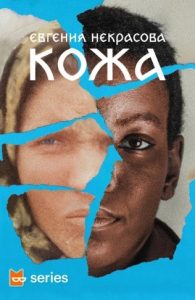 publishing the book in serial instalments, just as many nineteenth-century novelists, except that her book is appearing online – you have to subscribe to the BookMate platform to read her it. Nekrasova’s Skin tells the story of a young female Black slave, Hope, and a female serf called Domna, whose paths cross in nineteenth-century Russia. The two women discover that they can ‘exchange skins’ – to find out what that means, you’ll have to sign up to BookMate. As a white Russian woman, Nekrasova is aware that her novel might appear exploitative or ignorant; she insists, however, that ‘literature by Black women seems much closer to me, as a Russian-speaking female reader and writer, than 97% of all Russian literature’. According to Nekrasova, the collective female experience of oppression in patriarchal society gives her insight into the collective history of slavery – reading Toni Morrison’s Beloved inspired her to write about a Black slave. Nekrasova also studied Nancy Prince’s Narrative to inform Hope’s impressions of Tsarist Russia. Whether or not Nekrasova’s novel is successful, no doubt Nancy Prince would be happy that she is still inspiring Russians to think in creative, intersectional ways about Black history – and about their own…
publishing the book in serial instalments, just as many nineteenth-century novelists, except that her book is appearing online – you have to subscribe to the BookMate platform to read her it. Nekrasova’s Skin tells the story of a young female Black slave, Hope, and a female serf called Domna, whose paths cross in nineteenth-century Russia. The two women discover that they can ‘exchange skins’ – to find out what that means, you’ll have to sign up to BookMate. As a white Russian woman, Nekrasova is aware that her novel might appear exploitative or ignorant; she insists, however, that ‘literature by Black women seems much closer to me, as a Russian-speaking female reader and writer, than 97% of all Russian literature’. According to Nekrasova, the collective female experience of oppression in patriarchal society gives her insight into the collective history of slavery – reading Toni Morrison’s Beloved inspired her to write about a Black slave. Nekrasova also studied Nancy Prince’s Narrative to inform Hope’s impressions of Tsarist Russia. Whether or not Nekrasova’s novel is successful, no doubt Nancy Prince would be happy that she is still inspiring Russians to think in creative, intersectional ways about Black history – and about their own…
Dr. Muireann Maguire, Senior Lecturer in Russian
*For more on the differences between (and co-existence of) slavery and serfdom in Russia, see Ralph Hellie, ‘Slavery and Serfdom in Russia’, in A Companion to Russian History, ed. by Abbott Gleason (Blackwell, 2009), pp. 105-20.
**See John MacKay’s True Songs of Freedom: Uncle Tom’s Cabin in Russian Culture and Society (University of Wisconsin Press, 2013).
Students Re-Imagine Baudelaire: Through the Window and Into the Clouds
In September 2021, we welcomed returning final-year students back to their studies with a series of refresher classes after all the disruptions of 2020-21.
For one set of these classes, we set grammar books to one side and extended the great French poet Charles Baudelaire’s ‘Invitation to a Voyage’ to students. He claims that each one of us has an internal supply of natural opium to inspire and enthral us. In other words, the poet invites us to engage the limitless potential of our imaginations. Taking a leaf out of Baudelaire’s book, this particular class was to be an exercise in creative translation with an emphasis on the imagination.
Students looked briefly at one out of a pair of Baudelaire’s prose poems, namely ‘L’Étranger’ (‘The Stranger’ see English translation here) and ‘Les Fenêtres’ (‘Windows’, available in French and English translation here). They then had 15-20 minutes to produce their own version of it, by imagining their own encounter with a stranger in the clouds or by looking through a window in their mind onto a place of particular resonance for them.
The results are remarkable, a testimony to the innate creativity of our students who have already had to draw on their imaginations to think and be in another language. We also celebrate Baudelaire, who would have turned 200 in 2021, by extending his invitation to a voyage of the imagination.
Here’s the first set of poems based on ‘L’Étranger’:
In the clouds
- Are you alone here in the clouds?
- It is dark, it is raining.
- You are mysterious.
- I am not mysterious, I am afraid.
- You are afraid?
- Of light? Of darkness? Of joy? Of sadness?
- Of the world.
- But look down! The world is bright, the world is happy, the world is for everyone.
- So, why am I up here in the clouds?
Hannah Croutear
- So what’s your gimmick, then, Mr. Woke? Tell me about your family.
- I don’t have any worth speaking of, no parents or siblings.
- No friends then either?
- People come and go, for better or worse.
- And where do you come from?
- Many places, but what of them?
- And beauty?
- I see it everywhere, almost spiritually.
- Do you want riches? And fortune?
- Doesn’t seem to build a good lifestyle.
- So what do you even care for, since you have nothing left?
- Don’t you feel the breeze today? It’s so good to be here, wherever that is.
Afterthought:
Les richesses, et la fortune. Le sort. C’est quoi, sans les efforts pour les atteindre? C’est quoi, la vie, quand elle est remplie par les bêtises? C’est quoi, une maison, quand elle manque la porte? Et c’est quoi, une porte, quand elle attend toujours quelqu’un? Mur. Je vis, mais seulement quand les murs me permettent.
Mark Evans
En regardant les nuages rosâtres trébucher les uns sur les autres,
Je me demande serai-je jamais content ?
Le bonheur interne qui me manque devrait exister quelque part.
J’en suis sûr. J’en suis tellement sûr que ce néant me fait mal.
Les nuages quittent le ciel, révélant un azur aveuglant,
Avec son soleil fulgurant qui me brule les yeux
Et ses rayons qui embrassent ma peau,
Tout en déchirant mon corps en morceaux de l’intérieur.
Cependant, cette douleur me faire sentir à l’aise,
Elle me rappelle que je suis encore vivant
Soit à contrecœur, soit à dessein.
Jacob Farrington
-My body leaves me, floating in pure darkness. The silhouette asks, what is it like?
-It’s having no sensations, no responsibilities, no existence except from serenity.
-What was life like before? Says the silhouette
-Full of living, of existing, that world is still there but nowhere to be found.
-Is there fear?
-Not here
-Do you want to leave?
-Here I am a cloud, floating with no feeling, coming and going, sometimes existing, sometimes not.
Erica Harris
- Why is there only light?
- Because there is no darkness
- Where is the blue?
- There are only in orange and reds.
- What about words?
- There is nothing to say but to melt like the sun.
- And when does the sun rise?
- It only sets, moving towards the pink dusk.
Rhian Hutchings
Il se balade
Ses pas tombent avec soin
Sur le sol qu’il méprise
Plutôt, il préfère le ciel
Les nuages
Les autres, ils regardent leurs pas
Ses pensées sont à Terre
Mais il ne les connait pas
Il ne connait personne
Sauf ses amis nébuleux
Éphémères
Une fois rencontrés, ils disparaissent à jamais
Toujours différents, mais familiers tout de même
Cette amitié, c’est tout ce qu’il lui faut
Car le ciel le reflète
Toujours seul et jamais seul
Le ciel ne le quittera jamais.
Emily Maynard
He wanders
His feet tread carefully
Along the ground he ignores
Rather, he prefers the sky
The clouds
The others all stare at their feet
Their thoughts are of Earth
But he does not understand them
He does not understand anyone
Apart from his friends in the sky
Fleeting
Soon after meeting, they disappear forever
Always different, but familiar all the same
This friendship is all that he needs
Because the sky reflects him
Always alone and never alone
The sky will never leave him.
translated by Emily Maynard
Les Nuages
I’m watching the clouds,
They pass like time and life, across an ambiguous sky,
Will they darken and bring rain and life with them,
Or will they burn away and reveal the splendid sun above,
Revitalising, yet cruel.
The clouds intertwine, transforming into faces I once knew
And mesmerising patterns, drawing me further into my reverie…
A swallow soars upwards, undulating in the sky, headed towards the infinite universe above…
I wonder where she is she destined,
Is she returning home, to comfort and familiarity,
Or onwards, to new lands and uncertain skies,
To new ventures and risks,
Through turbulent tempests or over calm seas,
Skimming over waters of far-away lakes and oceans?
I will never know.
I wish her well with a nod of my head
And ponder what I’ll have for dinner…
Hannah Hall
And to conclude a pair of poems inspired by ‘Les Fenêtres’ (‘Windows’).
The sun bounces off the waves gently, casting a dim shadow in front of me as I look out over the sea. The small beacon of the lighthouse has lit up, a relic of safety from years gone by. We watch as the haze on the horizon creates murky skyscrapers, which rise from the sea as a lost city. Then, they pass, and we are left watching the container ships which have taken their place. Hundreds of goods transported from A to B. A floating island made of metal and oblivious to the numerous voyeurs on the shoreline.
A woman walks past on the beach with her dog, stopping only to pick up stones to throw for him. I wonder how far she has travelled to get here.
The window has a calming glow to it, a lulling sense of safety which beckons as if the warmth of the lowing sun is beating through it.
Isabelle Ferguson
The Window
I rise from my stupor, in the stuffy, shadowy room I call home in Exeter. I move lightly, guided by some deep yearning within me and open my window.
What awaits me is the most bright, bustling, and brilliant sight. My gaze settles on a waiter. His uniform pristine, his face set in a perfect, polite smile. He carries two overflowing flutes of deep golden liquid.
When he lays them on the ornate table bathed in perfect evening sunshine, my attention shifts to the women who grasp these glasses with fervour. Their skin is rosy, pricked by the strength of the sun’s rays.
The bustle softens, the music fades and what is left is the sound of their laughter. What beauty in that joyful noise? What envy to be as carefree as their shrieks of laughter sound?
I leave my room and join them, through my open window. The metal chair feels cool against my legs in this humid plaza in Northern Italy. Cold, bubbling, golden liquid glides into my mouth, leaving a trail of sticky warmth within me. I am boxed in by bold, boisterous buildings. Our table is pressed into a corner and yet I am the freest I’ve ever felt.
Sacha Warne
Recent Comments